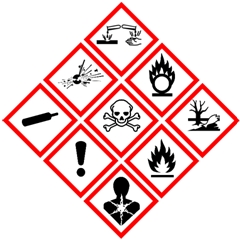GHS is an abbreviation for the Globally Harmonized System of Categorizing and Labelling Chemicals. Around the world, strict regulations are in place, requiring the classification of hazardous chemicals on labels. With a growing emphasis on safer packaging, the GHS label market will grow significantly in the coming years.
Manufacturers are expected to account for a larger share of GHS label demand among end users. According to the report, manufacturers are expected to account for more than half of the market demand.
Key Takeaways of GHS Labels Market Study:
Following a period of negative growth, GHS label sales are expected to improve marginally, with a 0.2 percent year-on-year increase in value in 2021.
The expansion of the chemicals sector will boost growth in the United States, allowing it to hold an 87 percent share of the North American market by 2021.
The United Kingdom will experience negative year-on-year growth in 2021, but sales are expected to improve in 2022 and beyond.
Germany’s sales will increase in 2021, but France’s sales will begin to recover in 2022.
Chemical production and exports have increased, establishing China as the dominant market in East Asia, followed by Japan and South Korea.
“Aside from the implementation of stringent regulations requiring the chemical sector to clearly state potential hazards, the focus on preventing product counterfeiting will provide tailwinds to the market’s growth,” said a lead analyst.
GHS Labels are in high demand as brand owners strive to prevent counterfeit products
The risk of commodity loss due to improper handling of hazardous chemicals while in transit exists for all modes of transportation, including rail, road, and sea. However, the use of globally harmonised system labels can assist shippers, buyers, and sellers of hazardous chemicals in ensuring safe and easy handling of hazardous chemicals.
The expansion of the chemical industry has fueled growth in a variety of markets, including that for GHS labelling. With the growing demand for labelling, manufacturers are also providing advanced labelling solutions to brand owners, such as chemical product tracking and tracing. However, a major challenge for logistics companies is chemical counterfeiting, which can be reduced by using GHS labels.
The expansion of the chemical sector, particularly in global markets, has resulted in the establishment of modern facilities that sell a wide range of product categories in bulk quantities. GHS labels reduce the possibility of package tampering, ensuring that products are delivered correctly to consumers. Various GHS label manufacturers provide labels that can be applied to a variety of substrates such as glass, paper, plastics, and so on, using cutting-edge technology such as RFID, and are used as unified classification for packaging in the chemical sector.
GHS Labels’ Space Constraints Will Slow Growth
Labels from a globally harmonised system are indicators of potential harms that can be caused by improper handling of a specific chemical or commodity. However, the sizes of GHS labels vary by commodity. Some commodities are packed in smaller packaging to save money on packaging, but the information for hazards may be greater than the space available. In those cases, the information is displayed in smaller or less visible sizes, which does not meet the safety requirements for hazardous chemicals and may result in loss of life or property.
GHS labels with incomplete information are more dangerous and have the potential to cause more harm during the use or handling of hazardous chemicals. The most serious and dangerous dangers are listed on the label, but the dangers that are less likely are not.
For example:- Because a chemical drum or bottle packed by the manufacturer is small in size, it may not be possible to label or depict in a pictorial manner all of the potential harms that mishandling of that product may result in.
Due to limited space, only the most dangerous hazards may be listed; however, due to a partial listing of hazards, there may be a loss of life or property during the use or handling of chemicals with incomplete information.









